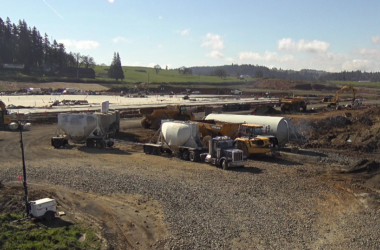
Gladys Blum, Blum Real Estate principal broker, puts a ‘sale pending’ banner on a real estate sign on Wednesday, March 24. (Amanda Loman/Salem Reporter)
With his wife and two kids cooped up during the pandemic, Derrick McIntosh’s two-bedroom south Salem apartment had become a “walkway” with almost no open space.
He and his wife had wanted to buy a house for nearly a decade but didn’t have the necessary income.
Then, last year, he got a better-paying state job that helped pay down debts. Interest rates dropped, making it easier to borrow money.
Meantime, the price of homes in Salem continued climbing.
“We did a lot of math on it and we decided it would be too risky to wait another year,” he said.
In December the couple waded into one of the most unusual housing markets Salem has seen in recent times. Unlike other economic downturns, plenty of people kept their jobs during the economic downtown caused by the pandemic. Many earned good pay while working from home.
But there are fewer houses for sale and they are more expensive, leaving a tight market for buyers like McIntosh.
The median price of a house under a half-acre in Salem and Keizer was $355,000 in February, up from $312,500 a year ago, according to data from the Willamette Valley Multiple Listing Service.
In February, there were 117 houses in Salem and Keizer under a half-acre for sale. A year ago that number was 382. In August 2019, 653 homes were on the local market.
Houses are selling quicker. In February, houses were on the market for 17 days. A year ago, it took 79.
South Salem has seen a 13% rise in average sale prices so far this year, the largest increase compared to nearby areas according to the service. Southeast Salem saw a 10% increase and west Salem a 7% increase. Marion County has seen an overall increase of 13%.
“Supply and demand drives prices, so we are sitting in a situation where we don’t have a lot of homes for sale but fairly high buyer demand,” said Chad Harvey, director of the Harvey Realty Group and president of the Mid-Valley Association of Realtors.
He said while data shows some parts of Salem are hotter than others, any house in decent shape and priced appropriately will have no problem selling. Homes in the mid-range area (which he put at around $325,000 to $550,000) are particularly competitive, said Harvey.
Blum said when the pandemic struck last year, she was ready to relax for a bit and instead watched the market take off. By last April she saw bidding wars erupt over homes that were going above their listing price.
“I thought with Covid we’d be slowing down,” said Gladys Blum, principal broker with Blum Real Estate. “But, no.”
She said higher-end homes that would sit on the market for six to nine months are now selling rapidly.
“It’s a feeding frenzy,” said Jennifer Atkinson, principal broker at Mark Atkinson Real Estate Inc.
She said the seller’s market means that buyers need to move fast on a home that meets their criteria and don’t have time to sleep on decisions.
Knowing that he was entering a competitive market, McIntosh took an aggressive approach when he and his wife started house hunting in December.
After researching the market, they set their target: three bedrooms, two baths, 1,500 square feet, built in 1990 or later, no homeowners association and $400,000 or less.
“Our strategy was if something came up for sale that met our criteria, we’d call our Realtor and look at it the same day,” he said.
He started receiving 50 email alerts a day from Zillow, Redfin and other real estate websites. One or two homes meeting his criteria would pop up every week. He’d take time off of work to look at the house where sometimes cars from potential homebuyers would already be lined up.
McIntosh said he looked at an “untold number” of houses online and looked at six in person. He said some houses had lumpy floors or leaky washing machines with tubs underneath them. They weren’t worth the price, he said.
The couple finally found a house in west Salem. They made an offer right away, which was turned down by the seller.
But a week later, the seller reconsidered. With 2.75% interest rate, which made the deal possible, his family closed the deal in February and moved in the next month.
McIntosh, 34, said it “stings” that buying a house has become so difficult for people who grew up in Salem and have saved for years. But he said buying the house was a needed transition with his kids, 6 and 8, who are getting bigger.
“You can’t time the market,” said McIntosh, who advises others in his situation to do their homework and be ready to move fast.
Harvey and other Realtors say it’s not clear what direct effects the pandemic has had on the real estate market and if it’s caused would-be sellers to pull their homes from the market. Instead, they say a key driver of increased demand has been low interest rates.
The U.S. economy plunged last spring after governors, including Gov. Kate Brown, enacted shutdown orders in response to the pandemic. Seeking to revive the economy, the Federal Reserve slashed interest rates, lowering lending costs for homebuyers.
Interest rates have stayed below 4% for all over 2020 and are now below 3%.
Blum, who has worked in Salem real estate since the late 1970s, said such low interest rates help heat up the housing market.
She tells clients who intend to sell that their homes will move quickly – but finding a replacement will be a challenge.
Homeowners looking for a bigger, better home have few options because of the low inventory, she said. That means those who can afford to move up are instead staying put, further constricting supply.
She said Salem hasn’t built enough houses to keep up with growth as the area attracts newcomers from California or the Portland area.
“I don’t know what’s going to happen,” she said. “This is a little different than it’s ever been before.”
Blum said Salem has long been among the most affordable in the state because of the steady supply of government jobs. A recent analysis by the Oregon Employment Department bears that out.
The analysis found that the average mortgage took around 24% of the monthly average wage compared to 35% in Bend and 44% in Hood River.
Harvey said the market could see a slight easing in price increases. But long-term, Salem’s housing market will face pressure as people are priced out of the Portland area. He said people will move to Oregon’s capital city for its livability and because it’s relatively easy to commute to nearby jobs.
Atkinson said the market is currently at a very high peak that’ll eventually have to subside.
“I don’t know how much longer this can go on for,” she said.
Contact reporter Jake Thomas at 503-575-1251 or [email protected] or @jakethomas2009.
SUBSCRIBE: A monthly digital subscription starts at $5 a month.
GIFT: Give someone you know a subscription.
ONE-TIME PAYMENT: Contribute, knowing your support goes towards more local journalism you can trust.









